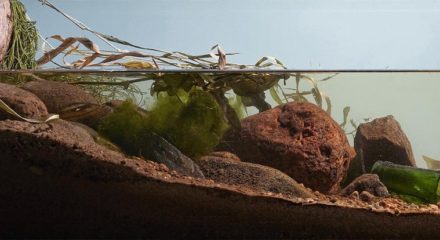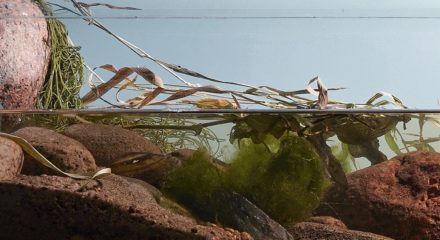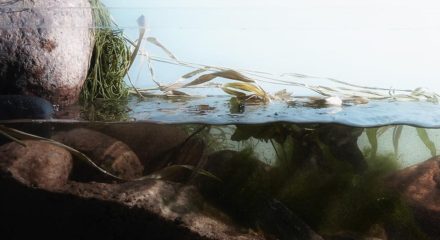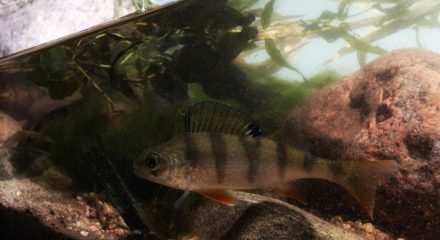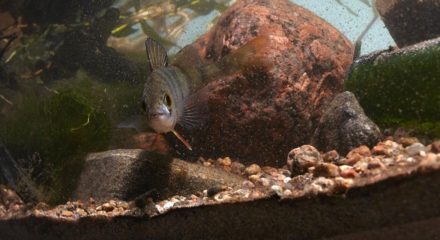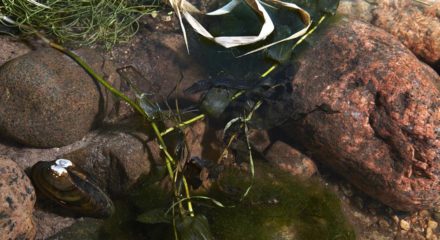Coastal area of Gulf of Finland in St. Petersburg
66th place in Biotope Aquarium Design Contest 2016
![]() Russia. Mark Martynov
Russia. Mark Martynov
Aquarium Volume: 160 L
Fish and invertebrates: Perca fluviatilis, Pseudanodonta complanata
Plants list: Potamogeton perfoliatus, Spirogyra sp.
Biotope description: The Gulf of Finland is located in the eastern part of the Baltic Sea and is the shallowest part of it. It washes the shores of Russia in the east, in the north of Finland and in the south of Estonia. In its waters there are many islands. Its maximum depth is about 100 meters, the most shallow bay in the eastern part is the so-called Neva Bay. It is less than 5 meters. Its length is 390 kilometers, its width at the entrance is 70 kilometers. It freezes at the end of November to mid-late April. In the Gulf of Finland fall large rivers: Neva, Luga, Narva. Under the influence of the river waters of the Gulf are desalinated. Only Neva gives to the Gulf every second more than 2500 cubic meters of fresh water. In the western part of the Gulf of Finland the water is less fresh than in the east, and reaches the level of salinity of the Gulf of Narva of 3-5 ppm at the surface and of 7-8 ppm at a depth of 50-60 meters. The Gulf of Finland is characterized by fluctuations in salinity, and in the bottom of the depressions is often marked oxygen deficiency. At the Neva Bay water drain waste is 1300 million cubic meters of wastewater per year, as well it is difficult to calculate how much falls into the Neva and its tributaries from the Ladoga. A significant part of polluting substances, organic compounds, heavy metals, oil products, phenols settle and accumulate in the Neva Bay. Such unfavorable ecological situation affects aquatic organisms. During the last 70 – 80 years in the Neva Bay species sensitive to water pollution vanished, and others are indicators of the contamination (Oligochaeta oligochaetes). In the Gulf of Finland (according to research in ichthyology Koporskaya Bay) 44 species of fish and lampreys live. Among them there are marine and freshwater species: Baltic herring lamprey, German sturgeon, herring, ide, bream, silver bream, saber fish, carp, bleak, perch, whitefish, salmon, smelt, dace. Two endemic species are found in the Gulf and Baltic. Aquarium was created based on the coastal bay area in the city in the autumn. Among the rounded granite stones of different sizes small perch (Perca fluviatilis) are hiding, waiting for prey. Scourge pondweed Potamogeton is ashore, thread algae form a characteristic “sponges” in the shallows. In the water and on the shore there are traces of human presence: broken glass, scraps of old fishing nets. We hope that, thanks to the numerous environmental projects, biological peculiarity of this unique place will not be lost.
Fish and invertebrates: Perca fluviatilis, Pseudanodonta complanata
Plants list: Potamogeton perfoliatus, Spirogyra sp.
Biotope description: The Gulf of Finland is located in the eastern part of the Baltic Sea and is the shallowest part of it. It washes the shores of Russia in the east, in the north of Finland and in the south of Estonia. In its waters there are many islands. Its maximum depth is about 100 meters, the most shallow bay in the eastern part is the so-called Neva Bay. It is less than 5 meters. Its length is 390 kilometers, its width at the entrance is 70 kilometers. It freezes at the end of November to mid-late April. In the Gulf of Finland fall large rivers: Neva, Luga, Narva. Under the influence of the river waters of the Gulf are desalinated. Only Neva gives to the Gulf every second more than 2500 cubic meters of fresh water. In the western part of the Gulf of Finland the water is less fresh than in the east, and reaches the level of salinity of the Gulf of Narva of 3-5 ppm at the surface and of 7-8 ppm at a depth of 50-60 meters. The Gulf of Finland is characterized by fluctuations in salinity, and in the bottom of the depressions is often marked oxygen deficiency. At the Neva Bay water drain waste is 1300 million cubic meters of wastewater per year, as well it is difficult to calculate how much falls into the Neva and its tributaries from the Ladoga. A significant part of polluting substances, organic compounds, heavy metals, oil products, phenols settle and accumulate in the Neva Bay. Such unfavorable ecological situation affects aquatic organisms. During the last 70 – 80 years in the Neva Bay species sensitive to water pollution vanished, and others are indicators of the contamination (Oligochaeta oligochaetes). In the Gulf of Finland (according to research in ichthyology Koporskaya Bay) 44 species of fish and lampreys live. Among them there are marine and freshwater species: Baltic herring lamprey, German sturgeon, herring, ide, bream, silver bream, saber fish, carp, bleak, perch, whitefish, salmon, smelt, dace. Two endemic species are found in the Gulf and Baltic. Aquarium was created based on the coastal bay area in the city in the autumn. Among the rounded granite stones of different sizes small perch (Perca fluviatilis) are hiding, waiting for prey. Scourge pondweed Potamogeton is ashore, thread algae form a characteristic “sponges” in the shallows. In the water and on the shore there are traces of human presence: broken glass, scraps of old fishing nets. We hope that, thanks to the numerous environmental projects, biological peculiarity of this unique place will not be lost.

